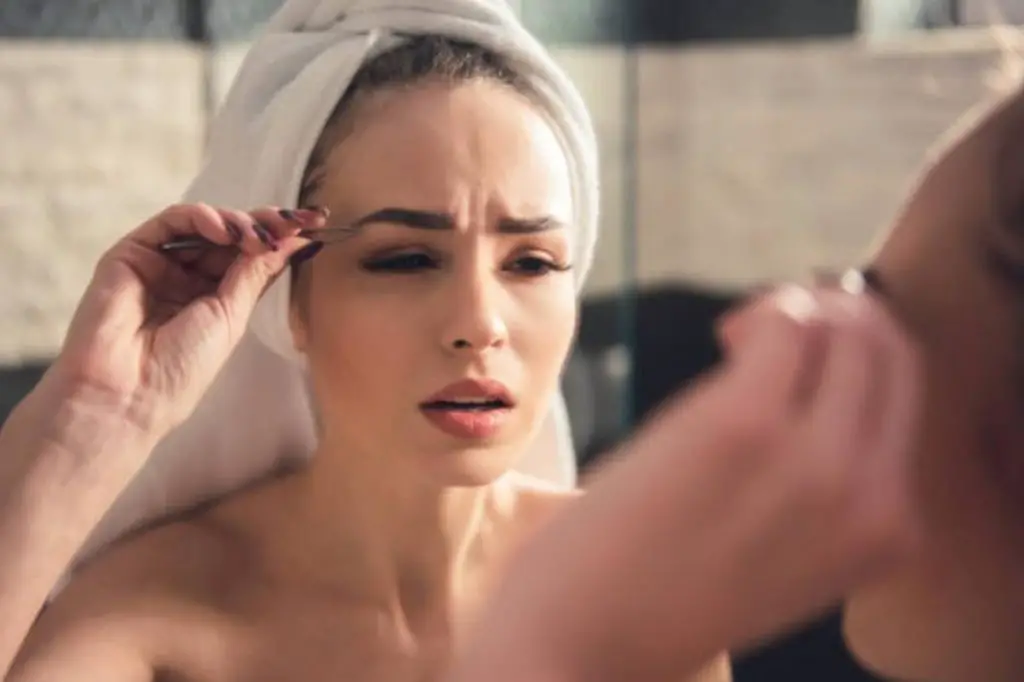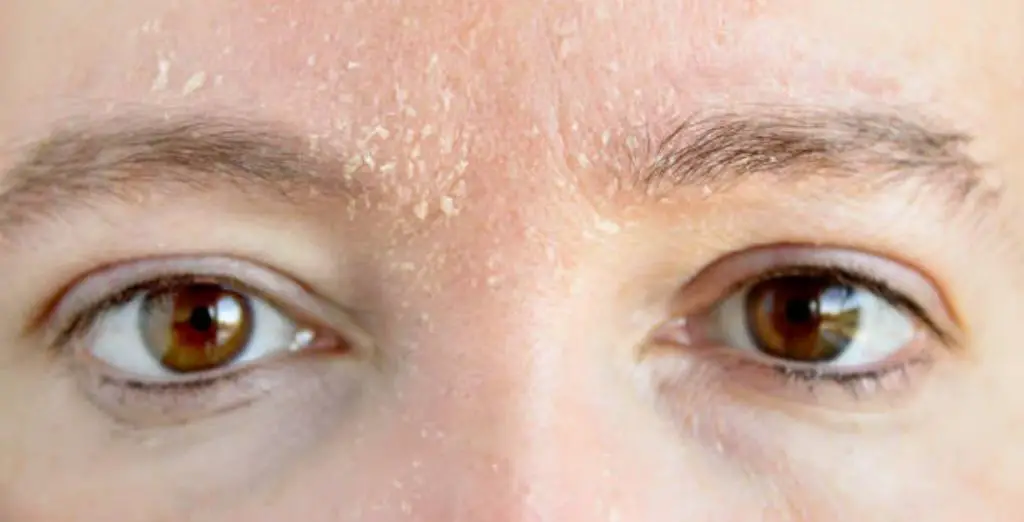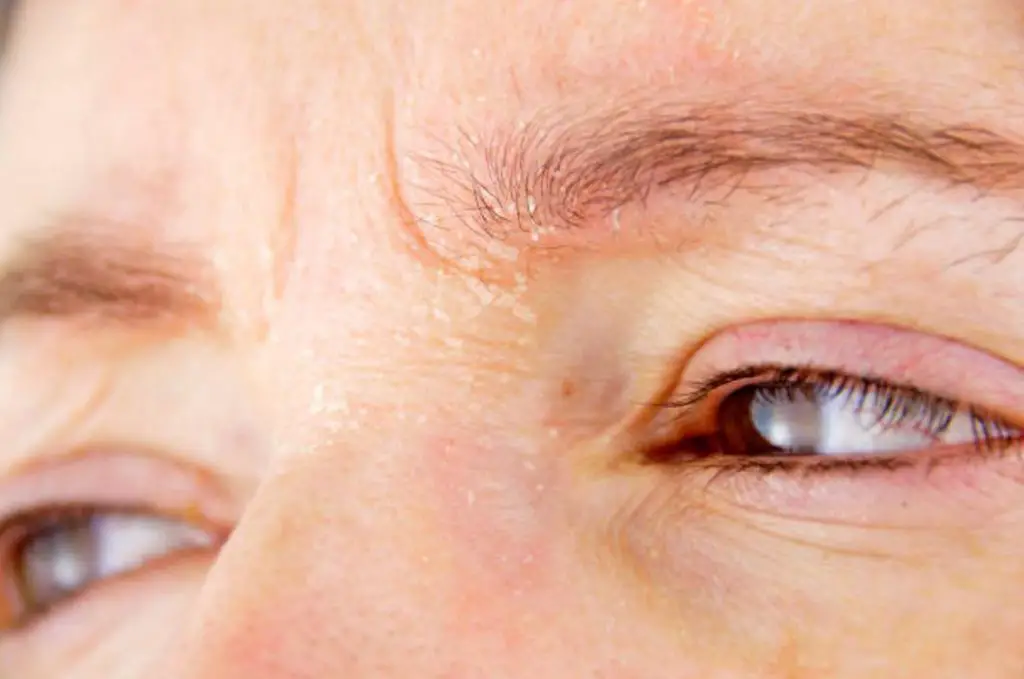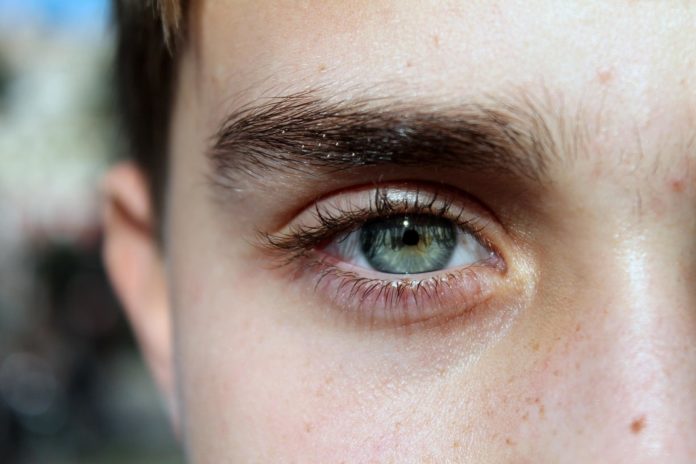Dandruff, which is scientifically known as Seborrhaic dermatitis or Seborrhaic eczema, is a common skin condition seen in many people. Seborrhaic dermatitis causes scaly patches and red skin, which gives rise to a messy and flaky appearance.
It commonly affects the scalp. It can also affect the body, such as eyebrows, eyelids, face, sides of your nose, ears, beard, and mustache area, and even chest. Sometimes dandruff goes away without treatment.
Dandruff is not contagious. Most of the time, repeated treatment is necessary for symptoms to subside. However, there is a high possibility of a return of symptoms.
What is Eyebrow dandruff?
When dandruff occurs in your eyebrows, there can be scaly patches over your eyebrows along with surrounding red skin. You may have itching. Sometimes there may be patches of greasy skin covered with flaky white or yellowish scales. When severe, crusts can form around your eyebrows.
Eyebrow dandruff is more commonly seen in teenagers and adults than in children. It is easy to spot as whitish oily-looking flakes or scales of dead skin over your eyebrows. Since it is itchy, when you scratch, the scales can worsen.
Eyebrow dandruff, along with other areas of seborrhaic dermatitis can be quite distressing, if you worry about your appearance. However, it is not a serious skin condition. The symptoms can worsen when you are stressed. Eyebrow dandruff, as well as other types of dandruff, can cause flares in cold and dry seasons.
Sometimes dandruff, including eyebrow dandruff, can get infected. Then the symptoms will worsen. Eyebrow dandruff is not contagious, which means it does not spread from one person to another.
What are the causes of eyebrow dandruff?

The cause of why people get dandruff is still unknown. However, dandruff, including eyebrow dandruff, is thought to be related to issues with your immune system, where irregular or a defective response triggers the symptoms.
The oil which is secreted on the skin can have yeast or a fungus called Malassezia. Many doctors think that this yeast can be a cause for your dandruff in your body as well as eyebrows.
Malassezia, although is a natural commensal (live as normal flora on the skin which is usually harmless) in many people, it can irritate the skin in some individuals, leading the skin cells to proliferate and grow. The extra skin cells die and fall off, which gives the appearance of flaky white spots on your eyebrows.
Dandruff can also occur when you have poor hygiene, especially when you don’t cleanse your face properly. If you do not wash your scalp and face regularly, skin cells and oils can build up, leading to dandruff.
If you have dry skin, you are more prone to develop dandruff than if you have oily skin. Dry skin tends to be scaly, which promotes dandruff.
Sometimes when you develop sensitivity or an allergic reaction to certain products used on the skin such as moisturizers, cleansers, eyeliners and eyebrow pencils, you can get contact dermatitis.
Contact dermatitis, when occurring in your eyebrows, can lead to eyebrow dandruff. If dandruff occurs due to contact dermatitis following sensitivity to a certain product, stopping the product will settle the eyebrow dandruff after some time.
What are the risk factors towards developing eyebrow dandruff?

Many factors can increase your risk of developing dandruff in your body as well as on your eyebrows. Some of the common risk factors are:
- During recovery from a stressful medical condition such as a stroke or a heart attack. Stress is a well -known risk factor to cause many diseases, including eyebrow dandruff.
- When you have a weak immune system such as; in certain cancers, alcoholism is associated with pancreatitis (inflammation of the pancreas), patients with HIV /AIDS, in recipients of organ transplant, etc. When your immune system is weak, the response to certain infections like fungus will not be proper.
- Some research has found that certain psychiatric and neurological conditions like depression, schizophrenia, and Parkinson’s disease may act as risk factors to develop eyebrow dandruff.
- During winter months, indoor heating can lead to dry skin, worsening your dandruff. Eyebrow dandruff will improve during summer months. Dry weather is a risk factor for getting eyebrow dandruff than humid weather conditions.
- Certain medications like immunosuppressant drugs and cancer chemotherapy can weaken your immune system increasing the risk of developing eyebrow dandruff.
- Sometimes irreversible factors like age and being a male matter towards developing dandruff. Dandruff usually begins in young adults and continues through middle age. However, it doesn’t mean that older adults and the elderly do not get it. Eyebrow dandruff is seen more in males than in females. Male hormones might play a role in causing eyebrow dandruff, according to some researchers.
What are the home remedies for eyebrow dandruff?
Eyebrow dandruff is challenging to cure. However, the good news is that it can be controlled.
While regular shampooing and daily cleansing of your eyebrows is a must to control your eyebrow dandruff, following self -care steps, and home remedies will help you to reduce the risk of developing dandruff.
- Control your stress – Stress can trigger both scalp and eyebrow dandruff or worsen the symptoms. By managing your stress well, you can keep your dandruff under control. Try practicing yoga, meditation techniques, deep breathing, and Aromatherapy, having a good sleep, and laugh often. Leading a stress-free life will automatically free you from eyebrow dandruff.
- Exposure to a little sunlight – Sunlight may help to control dandruff, therefore try spending a short time outdoors. However, too much exposure to Ultra Violet light of sun rays can damage your skin and increase the risk of Melanoma (skin cancer). Do not overexpose yourself to the sun without applying a good sunscreen over your face and body.
- Applying Tea tree oil – Tea tree oil can help reduce dandruff according to some studies. Tea tree oil is a natural antiseptic, antibiotic, and antifungal agent. Apply a little tea tree oil over your eyebrows daily to control dandruff. However, this oil can lead to allergies in certain individuals. If itching or burning sensation occurs, do not continue to use tea tree oil.
- Lemon juice – Massage a tablespoon of lemon juice over your eyebrows and rinse with water. The acidity of lemon juice can help balance the PH of your eyebrows and skin. You can continue this home remedy every other day to control your eyebrow dandruff.
- Apple cider vinegar – applying apple cider vinegar acts as a natural remedy to reduce dandruff. The acidity in apple cider vinegar helps to stimulate the shedding of dead skin cells. It also balances the PH of your skin and fights against the Malassezia yeast. Add a few drops of apple cider vinegar to your shampoo before washing your scalp and eyebrows. Do not use apple cider vinegar directly over your eyebrows as it can be harmful due to high acidity and damage your skin.
- Coconut oil – applying coconut oil over your eyebrows with dandruff improves hydration of the skin and prevents dryness. This also reduces itching and inflammation associated with dandruff. Coconut oil has anti-microbial properties that fight against Malassezia yeast. Massage virgin coconut oil daily into your eyebrows to keep your dandruff under control.
- Aloe Vera gel – Applying Aloe Vera gel over your eyebrows may help control your eyebrow dandruff. The anti-bacterial and antifungal properties in Aloe Vera can protect against eyebrow dandruff when applied daily. Aloe Vera is soothing to your skin and maintains hydration, which controls dandruff.
- Aspirin – Aspirin contains salicylic acid, which has anti-dandruff properties. It loosens flakes and gets rid of scaly skin. Crush 2 tablets of aspirin and add the powder to your shampoo before washing your scalp and eyebrows.
- Taking supplementations of Omega 3 fatty acids – Taking a capsule containing Omega 3 fatty acids daily, helps manage oil production and hydration of your skin. Deficiency of Omega 3 fatty acids is known to cause dry hair, dry skin, and even dandruff. Omega 3 fatty acids reduce inflammation and relieve irritation associated with dandruff. Oily fish like trout, mackerel, and salmon, flaxseed, Chia seeds, and walnuts are found to be rich in Omega 3 fatty acids.
- Eating probiotics – Probiotics are live bacteria and yeast, which are good for you, especially for your digestive system. Probiotics are found in fermented foods such as yogurt, kefir, sauerkraut, tempeh, and Kimchi. They help to enhance your immune function. This can help your body to fight against fungal infections, which cause dandruff.
- Applying Baking soda – Wet your eyebrows and directly massage baking soda for a minute or two and wash off. Continue this home remedy daily. Baking soda has antifungal properties, which can help in controlling eyebrow dandruff.
These lifestyle modifications and home remedies can work for many people who have scalp as well as eyebrow dandruff. These methods may work on some but not for another.
If it works, you can continue the same method to keep your eyebrow dandruff under control. However, if these do not work, you will have to go for medicated shampoo or lotion to treat and control your eyebrow dandruff.
What are the treatment options for controlling eyebrow dandruff?

Since eyebrow dandruff is almost always associated with scalp dandruff, it is vital to cleanse your scalp well with a medicated shampoo. You can use the same shampoo to cleanse your eyebrows and any other area of your body where you are affected with dandruff.
If your eyebrow dandruff is mild, you may not need any specific treatment. Cleansing your face and eyebrows daily with a gentle cleanser will be adequate. If your dandruff is stubborn and does not respond to daily cleansing, you will have to go for a medicated cleanser or a lotion.
There are many over the counter (OTC) dandruff lotions and shampoos which are available in the market.
Daily cleansing prevents skin cell build-up, thus controlling mild dandruff. All OTC products which are available in the market for dandruff may not work for everyone. Sometimes you may have to try several treatments and home remedies to succeed. By trial and error, you should be able to find the best solution for you.
If you develop more itching, burning sensation, stinging, or redness to an anti-dandruff product, stop it and do not use it again. If you develop an allergic reaction like hives (urticaria), a rash, or if you find it difficult to breathe, seek medical help immediately.
Dandruff medications and shampoos can be classified according to the medications it contains.
Pyrithione Zinc – This active ingredient is found in Head and shoulders shampoo, Jason dandruff relief 2 in 1, etc.
Zinc Pyrithione is an anti-bacterial and antifungal agent. It can reduce the Malassezia fungus on your scalp and eyebrows, which can cause dandruff.
Salicylic acid – This active ingredient is found in Neutrogena T/Sal.
Salicylic acid works as a scrub and eliminates scales. But it can leave your face and scalp dry, leading to more flaking. If used on the scalp, make sure you follow the shampooing with a suitable conditioner. If used on face and eyebrows, moisturize your face to relieve dryness.
Tar based shampoos – This active ingredient is found in Neutrogena T/gel.
Coal tar helps dandruff by slowing the process of skin cell death and flaking off, thereby controlling dandruff.
Selenium sulfide – This active ingredient is found in Selsun Blue and Selson shampoo.
Selenium sulfide slows skin cells from dying as well as reduces Malassezia yeast, which is thought to cause dandruff in both scalp and eyebrows.
Coal tar and Selenium sulfide can discolor your scalp hair and eyebrows if they are initially light in color. Make sure you rinse your eyebrows and hair thoroughly if you use these products to control your dandruff.
Ketoconazole – This active ingredient is found in Nizoral.
This is a broad spectrum antifungal that kills the Malassezia yeast. It is available as OTC as well as by prescription in higher strengths. Ketoconazole shampoos and lotions can be tried when other medications fail to control your dandruff.
Here are some of the products that can be recommended to use for eyebrow dandruff.
Nizoral anti-dandruff shampoo non -prescription strength – The active ingredient here is 1% Ketoconazole, which fights dandruff outbreaks. It is safe enough to be used on color-treated or chemically processed hair. It is gentle and can be applied on scalp and eyebrows and rinsed off after a few minutes.
Head and shoulders shampoo – This contains Selenium sulfide as the active ingredient. It can be used to wash the scalp and eyebrows, which helps to relieve itching, flakes, and dryness.
There is also Head and shoulders shampoo, anti-dandruff clinical strength seborrhaic dermatitis treatment, which can be recommended for multi-symptom relief and protection from flakes, itching, and dryness.
Mizani scalp care – Pyrithione zinc anti-dandruff shampoo – Pyrithione zinc acts as an anti-bacterial and antifungal agent that fights against the fungus and controls dandruff in both eyebrows and scalp.
Solimo dandruff shampoo – This product contains Pyrithione zinc as the active ingredient which helps to prevent itching and flaking when applied to scalp and eyebrows. The almond oil, which is added, keeps the scalp and eyebrows hydrated, preventing dryness.
Biolage Scalpsync anti-dandruff shampoo – Pyrithione zinc, which is the active ingredient, helps target dandruff and control the appearance of visible flakes in both scalp and eyebrows.
You can use one of the above-mentioned shampoos or lotions over your scalp and eyebrows daily or every other day until your dandruff is controlled. Then you can reduce the frequency of treatment to two to three times a week or as needed.
Sometimes when you continue to use a medicated shampoo for a considerable time, although it helped to control your eyebrow dandruff before, it might lose its effectiveness with time. If this occurs, try altering between 2 different types of medicated dandruff shampoos and lotions.
Ex: use Nizoral shampoo for 1 month, then selenium sulfide for the next month, and again alternate between the two products.
When you use an over the counter product or a product, make sure you read and follow the instructions which are on the container. Some shampoos and lotions like Nizoral have to be left on scalp and eyebrows for a few minutes before rinsing off, whereas some products like coal tar need to be rinsed off immediately after applying.
If your eyebrow dandruff doesn’t get controlled, even after using a recommended product regularly and as instructed for several weeks, it is best to meet your doctor or a dermatologist. In this instance, you will need a prescription for a stronger preparation of a shampoo or a lotion.
Sometimes your doctor will start a short course of steroids or a steroid containing lotion to control your eyebrow dandruff.
When should you seek help from a doctor?
- When your eyebrow dandruff causes you anxiety and embarrassment
- When the discomfort is too much, and it causes you to lose sleep over it and disrupt your daily routine activities.
- When your eyebrow dandruff becomes infected
- Worsening of dandruff with time
- When you have tried several home remedies and self -care steps, but still no success.
- If your dandruff does not get controlled to a recommended OTC medicated product, even after using regularly and as instructed for some time.
What are the complications of eyebrow dandruff?
- Eyebrow dandruff can cause it to get infected, especially if you constantly scratch the area. Germs can get in if the eyebrow area gets damaged, leading to redness and even pus-forming lesions. Crusting can occur when lesions dry up, and pain may arise from infected lesions.
- Prolonged and untreated eyebrow dandruff can cause anxiety and even depression in some individuals, especially if they constantly worry over their appearance.
Although complications are rare from eyebrow dandruff, it is better to control your symptoms to prevent possible complications.
Take home message
It is important to know that Eyebrow dandruff is difficult to treat, and it is not curable. It can only be controlled. Therefore, when you stop the treatment even after successful control, dandruff can recur after some time. Make sure you continue to cleanse your scalp and eyebrows regularly to keep your dandruff under control while maintaining good personal hygiene and self -care.
You have to accept the fact that you are a person who is prone to get dandruff if risk factors are not managed well. As there is no cure, you can only take measures to reduce the shedding of dead cells from your scalp and eyebrows.
You can control or get rid of your dandruff by using a good medicated shampoo/ lotion or a gel or by practicing simple home remedies. However, you can only expect to control your eyebrow dandruff and keep it from coming back by these methods and not a complete cure.
References:
- https://www.mayoclinic.org/diseases-conditions/seborrheic-dermatitis/symptoms-causes/syc-20352710
- https://www.mayoclinic.org/diseases-conditions/dandruff/symptoms-causes/syc-20353850
- https://www.mayoclinic.org/diseases-conditions/dandruff/diagnosis-treatment/drc-20353854
- https://www.healthline.com/nutrition/ways-to-treat-dandruff#section8

